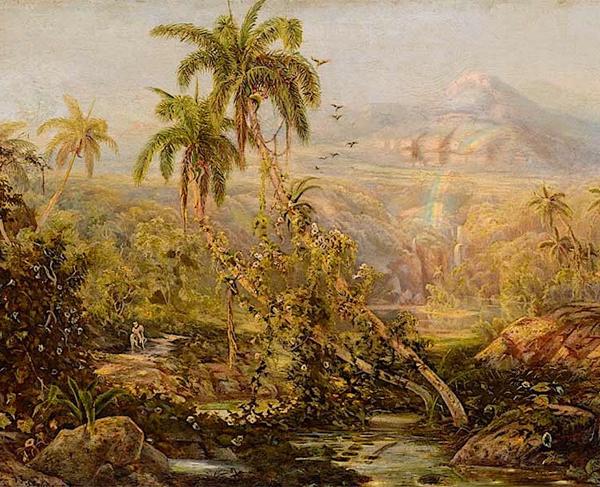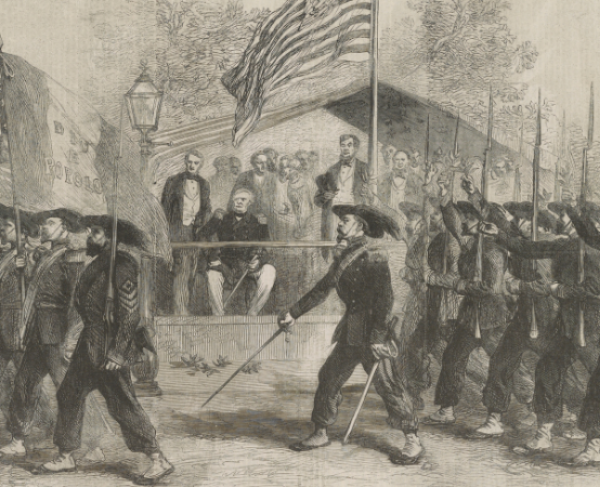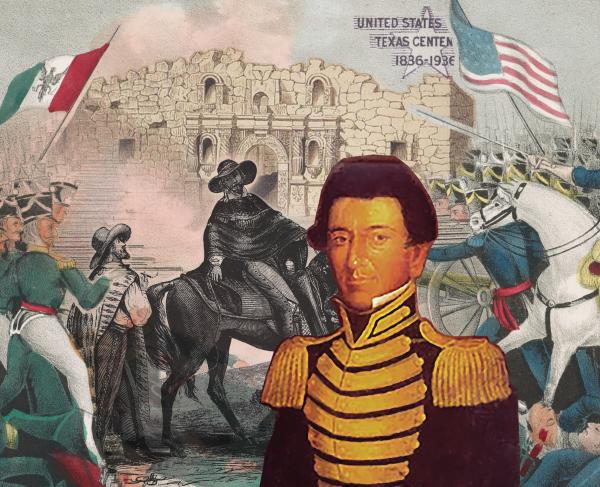The Impact of the Mexican American War on American Society and Politics

On February 2, 1848, the Treaty of Guadalupe Hidalgo was signed which officially ended the Mexican-American War. However, as the guns fell silent, and the men returned home, a new war was brewing, one that continues to shape the course of this country to this day.
While Ulysses S. Grant might have argued that the Civil War was God’s punishment for the Mexican-American War, a “wicked war" that was rooted in imperialism and the expansion of slavery, many Americans supported the Mexican-American War as they viewed it as the fulfillment of Manifest Destiny: the promise that the United States would extend from “sea to shining sea.” While Manifest Destiny remains a core of U.S. national identity, in the 1840s it encouraged a slew of ideological debates over this potential new territory, specifically if the territory should be free or enslaved. The Louisiana Purchase caused a major crisis over the organization of new states which Congress ultimately resolved with the Missouri Compromise, the compromise to end all compromises. It is important to note that the debates in 1820 were largely split among party lines, i.e. Democrats vs. Whigs. However, the Mexican American War reopened past wounds and sent the United States into another legislative crisis.
Even before the war was won and territory had been ceded, Congress was already discussing how to organize any potential new territory gained as reparations from Mexico. One of the most important of proposals was the Wilmot Proviso which Representative David Wilmot of Pennsylvania proposed in 1846, two years before the war ended. Under this proviso, any territory gained by war with Mexico should be free and thus reserved exclusively for whites. Wilmot was a free-soiler, which meant that he did not want to abolish slavery in the places it currently existed but rather prevent its expansion to new territories. However, Wilmot was also a Northern Democrat, and most Democrats supported slavery and protected it, even if they themselves did not own slaves. Many Northern Whigs believed in something called the Slave Power Conspiracy, a conspiracy theory in which slaveowners (the Slave Power) dominated the country’s political system even though they were a minority group, which was accomplished through a coalition with “dough-faced Democrats,” Northern Democrats who supported and protected slavery. While the Wilmot Proviso failed in the Senate, it passed in the House of Representatives because of a coalition between Northern Democrats and Northern Whigs and illustrates the first shift from party alliances to sectional alliances. Indignation over the Wilmot Proviso united southerners against northern threats to their most valuable institution, slavery. After this vote, the antebellum political landscape was forever changed.
The failure of the Wilmot Proviso only put off the issue of slavery for so long. With the Treaty of Guadalupe Hidalgo, Mexico ceded over 525,000 square miles of territory to the United States in exchange for $15 million and the assumption of Mexican debts to American citizens, which reopened the slavery issue. In order to promote party loyalty without aggravating sectional tensions, the Whigs did not include specific resolutions on slavery in their official platform for the Election of 1848. The Democrats ran on popular sovereignty, which is the idea that the status of a territory will be determined by the people residing in that territory. Popular sovereignty is neither explicitly pro-slavery or anti-slavery; however, it does nullify the Missouri Compromise. Neither party adopted a firm stance on slavery in the 1848 election; however, the free-soilers made the election about slavery. Consequently, the Whigs and the Democrats developed campaign materials to be sectionally distributed which highlighted their candidate's support and opposition for slavery respectively. The separate campaign materials in this election reveal the growing sectional divide in antebellum America.
Despite the growing sectionalism, Zachary Taylor, a hero of the Mexican-American War and a slaveholding Whig was elected president in 1848 and served for two years before dying in office of natural causes. The Mexican-American War projected Taylor into a position of celebrity and enabled his election in 1848. After his election, Taylor promised not to intercede with Congress’s decision for the organization of the Mexican Cession. Many southerners felt betrayed by Taylor, a slaveowner from Louisiana, as they equated his position with those of a free-soiler. In this time of heightened sectional tensions, southerners believed that if one did not actively protect slavery and its expansion, one supported abolition.
As a direct result of the Mexican Cession, the California Gold Rush began in 1849 which caused a massive frenzy to organize and admit California into the Union. The Missouri Compromise stated that any territory north of the 36°30’ parallel would be free; however, the line would divide California into two sections. California was never a US territory and approved a free constitution, elected a Governor and legislature and applied for statehood by November 1849. Since California did not wish to be divided into two separate states, a new compromise was formed, aptly named the Compromise of 1850. Under the Compromise of 1850, California was admitted as a free state without deciding the fate of the remainder of the Mexican Cession. Additionally, under this compromise, there was the federal assumption of Texas debt, the abolishment of the slave trade in the District of Columbia, and a stronger fugitive slave law. While controversial, the Compromise of 1850 alleviated the growing tensions over slavery and delayed a full-blown crisis over the issue.
However, in 1854 tensions over slavery once again skyrocketed over the organization of Kansas and Nebraska. While Kansas and Nebraska were not part of the Mexican Cession, their debates over their organization are linked to the Mexican-American War. As stated above, the Mexican-American War re-opened the discussions over how to organize territory, and one of the proposed solutions was popular sovereignty. While the Compromise of 1850 elected not to include popular sovereignty, it reemerged in 1854 with the Kansas-Nebraska Act, where Kansas and Nebraska would be organized using popular sovereignty. The Kansas-Nebraska Act caused Bleeding Kansas, where pro-slavery and anti-slavery Americans flocked to Kansas in an attempt to establish either a slave or free government in that state, which eventually erupted into violence where neighbor killed a neighbor in the name of slavery and abolition. Bleeding Kansas is also the first instance where John Brown, famous for his 1859 raid on Harper’s Ferry, used violence to enact his radical abolition vision. Moreover, the Kansas-Nebraska Act propelled future President Abraham Lincoln into the national spotlight. The Kansas-Nebraska Act was Senator Stephen Douglas of Illinois’s pet project and popular sovereignty is often associated with Douglas. Lincoln and Douglas engaged in a series of debates in 1858, which mainly focused on popular sovereignty and slavery’s expansion. While Lincoln lost the senatorial election in 1858 to Douglas, he became well known because of the debates, which positioned himself to be the Republican candidate for the Presidential Election of 1860. Additionally, the Kansas-Nebraska Act was the final nail in the coffin for the Whig Party and paved the way for the establishment of the Republican Party, the first prominent anti-slavery party which was rooted in sectionalism.
Ralph Waldo Emerson prophetically wrote, “Mexico will poison us.” The Mexican-American War and the massive territory gained reopened debates over slavery which diminished party alliances and increased sectional alliances. These debates over slavery eventually led to the demise of the Second Party System and paved the way for the rise of Republicanism. Sectional tensions had never been stronger and there were open discussions of disunion which increased as the 1850s progressed. All these tensions and issues would come to head with the Election of 1860 and eventually with the Civil War, where brother fought against brother. To say "Mexico poisoned" the United States is an understatement, the bloodshed during the Civil War rivaled any other American conflict and today we are still in the process of healing wounds that occurred over 150 years ago.
Further Reading:
- So Far From God: the U.S. War with Mexico 1846-1848: By John S. D. Eisenhower
- A Wicked War: Polk, Clay, Lincoln, and the 1846 U.S. Invasion of Mexico: By Amy S. Greenberg
- The Fate of Their Country: Politicians, Slavery Expansion and the Coming of the Civil War: By Michael F. Holt
- The Impending Crisis: America Before the Civil War 1848-1861: By David M. Potter


